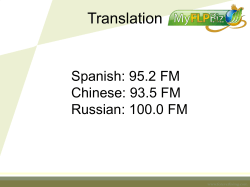
poster
BIO-Protect for fast-alert biodetection European Union FP7 project. Duration: 44 months. Start date June 2010. EC contribution: € 3.1 M (Total budget : € 3.9 M ) http://fp7-bioprotect.eu/ Introduction The malevolent use of Anthrax spores on civilians has shown the necessity to protect citizens from criminal use of biological agents. Detecting pathogenous bacteria, including spores, viruses and toxins has to be accomplished by triggering short-term alarm and identification of the type of threat. BIO-Protect, a European project comprising 7 partners, has developed a fast-alert, easy-to-use device for the detection and identification of airborne bacteria, spores, viruses and toxins. Its technology is based on bio-aerosol detection by laser-induced fluorescence and elastic scattering followed by particle collection from air, pyrolysis of the sample and analysis by Gas Chromatography-Ion Mobility Spectrometry (GC-IMS), which enables the identification of harmful biological agents. This device will provide security personnel with a reliable tool to take fast, effective countermeasures when confronted with biological threats and will reduce the potential impact of terrorist attacks or accidental releases of bio-agents from laboratories. Basic prototype characteristics Size (H x W x D): 79 x 61 x 44 cm (with inlets installed) Weight: 42 kg Battery pack weight (including AC power): 12 kg Data Interfaces: WLAN + USB + Ethernet Sampling method: The biodetector samples by continuously pumping a stream of ambient air through a pre-filter and virtual impactor The particle collector samples by electrostatic precipitation Air flow rate: Biodetector sampling 2 lpm Particle collector sampling ca. 100 lpm Estimated battery operating time: 5 hours at +20 °C Target response time (detection and identification of agent): less than 15 min About the technology Main Hardware Bio-Protect was designed based on existing technologies and pre-defined specifications. An end-users group was involved in the process by providing requirements that were taken into account as much as possible during the design and integration work. The device is composed of four main sub-assembly units that have been redesigned, modified or miniaturised: Bio-aerosol detector: The BioScout bio-aerosol detector developed and used in other detection devices by Environics, was modified for better integration suitability and mobile use. It continuously monitors the ambient air and triggers a measurement if biological particles are detected. The device detects particles ranging from 0.5-10 micrometres. Particle collector: A single stage electrostatic sampler was developed by CEA Leti for an efficient collection of microorganisms at 100 l/min. The corona discharge between coaxial cylinders changes airborne particles into electrically charged particles that can be collected by electrical forces as they pass through the sampler. The current sampler design features a high flow rate that enables the device to be used as an alarm trigger in a short period of time. Pre-treatment unit: A combined pre-concentration and pyrolysis unit for sample pre-treatment was developed by C-Tech Innovation. A small amount of the collected aqueous sample is transferred to the unit’s pyrolysis tube, which contains a special support medium. The sample is first heated at low temperature to dry the sample and a special valve unit prevents any water vapour entering the detector. After all of the water is removed, the sample residue is then pyrolysed quickly at high temperature to release characteristic volatile organic materials from the sample into the air-stream. To prevent the condensation and loss of any volatile materials, the valve unit then directs the air-stream through heated transfer lines before it enters the IMS detector. GC-IMS: A miniaturised and modified GC-IMS, developed by Environics-IUT, for pyrolysis gas analysis separates and identifies very small amounts of a wide range of molecules. It has been adapted to sense organic compounds that have been decomposed by means of pyrolysis. The selected GC-column has been conditioned for this special application. The coupling of a GC column with an IMS system enhances the selectivity of a bare IMS system and extends the two dimension information of IMS to a three dimension information of a GC-IMS. Main Software Pattern analysis software has been developed for the interpretation of acquired spectra, identifying bio-agents and distinguishing them from other biological materials. A database of several model-agents including bacteria, spores, toxins and viruses has thus been generated. Constant extension and upgrading of the database is planned, leading to the delivery of a marketable version with an extended scope. Users control and monitor the device through an easy, dedicated user interface. Two versions have been developed, for basic users and for advanced users. During the analysis, users can follow the different steps of the process, receive alarms, see results and acquired spectra, and access past analysis data. How does it work? Bio-Scout continuously measures the ambient air by laser-induced fluorescence and scattering to detect potentially harmful biological agents. If biological particles are detected, it triggers the analysis process. . The particle collector begins to collect particles from the air onto its cylinder walls and stops when the pre-defined collection time has elapsed. Particles are flushed from the collector’s cylinder walls with aqueous flushing solution. A sample is then transferred to the pre-treatment unit through the sample transfer line. A small amount of the aqueous sample is first dried in the pre-treatment unit’s pyrolysis tube and then pyrolysed quickly at high temperature. Gases released from the pyrolysis process are transferred to the GC-IMS unit for analysis. Upon gas analysis, an indication of the result is displayed on the user interface. RESULT Detection & identification of bio-agent Next steps Further tests are planned to continue to improve the prototype device with regards to technology and the interface for users. Exploitation and marketing studies are being undertaken by partners in the project with a view to commercialise the device. 7 partners in 5 countries The research leading to these results is partly funded by the European Community’s Seventh Framework Programme FP7/2007-2013 under grant agreement No. 242306 Contact: Vincent Chauvet - LGI Consulting 13 Rue de Marivaux, Paris FRANCE email : vincent.chauvet@lgi-consulting.com tel: +33 (0) 1 84 16 30 73
© Copyright 2025













